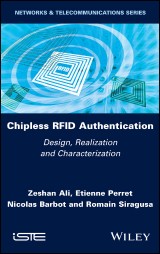Details

Chipless RFID Authentication
Design, Realization and Characterization1. Aufl.
|
126,99 € |
|
| Verlag: | Wiley |
| Format: | |
| Veröffentl.: | 11.08.2022 |
| ISBN/EAN: | 9781394164035 |
| Sprache: | englisch |
| Anzahl Seiten: | 192 |
DRM-geschütztes eBook, Sie benötigen z.B. Adobe Digital Editions und eine Adobe ID zum Lesen.
Beschreibungen
Chipless RFID Authentication examines the development of highly secure product authentication systems for manufactured products by using chipless radio frequency identification (RFID) technology.<br style="box-sizing: border-box; color: #212121; font-family: latoregular; font-size: 18px; text-align: justify;" /><br style="box-sizing: border-box; color: #212121; font-family: latoregular; font-size: 18px; text-align: justify;" />The absence of a chip and its compatibility with mass production make chipless RFID an alternative to barcodes. This book discusses how, by using natural randomness inherent to the fabrication process, each chipless RFID tag has a unique signature that can never be reproduced, even if someone tries to copy the label.<br style="box-sizing: border-box; color: #212121; font-family: latoregular; font-size: 18px; text-align: justify;" /><br style="box-sizing: border-box; color: #212121; font-family: latoregular; font-size: 18px; text-align: justify;" />The book first explores the state-of-the-art of existing authentication and anti-counterfeiting methods based on their security level. Next, a methodology describing the characterization of chipless RFID tags for the authentication application is presented, followed by a discussion of the extraction of aspect-independent parameters for chipless RFID tags. After proposing designs for the tags, the book presents the realization and characterization of the labels (which exhibit naturally occurring randomness) for authentication, using printed circuit boards and inkjet printing on polyethylene terephthalate.
<p>Preface ix</p> <p><b>Chapter 1 Introduction to Chipless Radio Frequency Identification 1</b></p> <p>1.1 Introduction 1</p> <p>1.2 Chipless radio frequency identification 1</p> <p>1.3 Recent developments and advancements 4</p> <p>1.4 Authentication 14</p> <p>1.5 Conclusion 15</p> <p><b>Chapter 2 Literature Review 17</b></p> <p>2.1 Introduction 17</p> <p>2.2 State of the art 18</p> <p>2.2.1 Basic level of security (overt or visible features) 20</p> <p>2.2.2 Medium level of security (covert or hidden markers) 22</p> <p>2.2.3 High level of security (forensic techniques) 23</p> <p>2.2.4 Conventional RFID approaches 24</p> <p>2.2.5 Classical chipless approaches 27</p> <p>2.2.6 Natural randomness 28</p> <p>2.3 Conclusion 30</p> <p><b>Chapter 3 Methodology and Proof of Concept 31</b></p> <p>3.1 Introduction 31</p> <p>3.2 Randomness inherent in the realization process 32</p> <p>3.3 Authentication procedure 34</p> <p>3.4 Statistical analysis 37</p> <p>3.5 Chipless tag discrimination using PCB tags 39</p> <p>3.5.1 Chipless tag design and purposely applied dimensional variations 40</p> <p>3.5.2 Chipless tag discrimination results and performance of the resemblance metrics 44</p> <p>3.6 Chipless tag discrimination using inkjet-printed paper tags 47</p> <p>3.6.1 Chipless tag design and purposely applied dimensional variations 47</p> <p>3.6.2 Chipless tag discrimination results and performance of the resemblance metrics 48</p> <p>3.7 Conclusion 51</p> <p><b>Chapter 4 Extraction of Chipless Tag Key Parameters from Backscattered Signals 53</b></p> <p>4.1 Introduction 53</p> <p>4.2 Chipless RFID tags and measurement setup 57</p> <p>4.3 Extraction of aspect-independent parameters of a second-order scatterer 61</p> <p>4.3.1 Extraction with the matrix pencil method 64</p> <p>4.3.2 Extraction with the spectrogram method 67</p> <p>4.4 Extraction of CNRs of the multi-scatterer-based tags 73</p> <p>4.5 Comparison of computational time durations between the matrix pencil method and the spectrogram method 82</p> <p>4.6 Conclusion 83</p> <p><b>Chapter 5 Chipless Authentication Using PCB Tags 85</b></p> <p>5.1 Introduction 85</p> <p>5.2 Design and the optimization of chipless tags to be employed for authentication 86</p> <p>5.2.1 C-folded uni-scatterer tags (classical design) 87</p> <p>5.2.2 C-folded quad-scatterer tags (optimized design) 94</p> <p>5.3 Detection of minimum dimensional variation in outdoor realistic environment and authentication results 100</p> <p>5.4 Detection of natural randomness and authentication results 106</p> <p>5.4.1 Authentication within each realization 108</p> <p>5.4.2 Authentication across different realizations 111</p> <p>5.4.3 Characterization of the natural randomness 112</p> <p>5.4.4 Generalization of the proposed method 117</p> <p>5.4.5 Final remarks on the constraints 118</p> <p>5.5 Conclusion 119</p> <p><b>Chapter 6 Chipless Authentication Using Inkjet-Printed PET Tags 121</b></p> <p>6.1 Introduction 121</p> <p>6.2 Optimization of chipless tags to exploit natural randomness inherent in inkjet printing 122</p> <p>6.3 Authentication using VNA-based chipless reader 129</p> <p>6.4 Authentication using IR-UWB chipless reader 136</p> <p>6.5 Conclusion 142</p> <p>Conclusion 145</p> <p>Appendices 149</p> <p>Appendix A 151</p> <p>Appendix B 153</p> <p>Appendix C 155</p> <p>References 157</p> <p>Index 173</p>
Zeshan Ali is a postdoctoral researcher with the Grenoble INP, part of Université Grenoble Alpes, in France. He specializes in the design of RF/microwave circuits for chipless RFID tags and systems, radar signal processing, multi-band filters, reconfigurable filters and optimization methods.<br style="box-sizing: border-box; color: #212121; font-family: latoregular; font-size: 18px; text-align: justify;" /><br style="box-sizing: border-box; color: #212121; font-family: latoregular; font-size: 18px; text-align: justify;" />Etienne Perret is an Associate Professor with the Grenoble INP, part of Université Grenoble Alpes. He is interested in electromagnetic modeling of passive devices for millimeter and submillimeter-wave applications, wireless communication systems including RFID and chipless RFID technologies, non-volatile nano-ionic RF switches, and advanced computer-aided design techniques based on the development of automated co-design synthesis computational approaches. He has contributed to numerous pioneering works in the field of chipless RFID.<br style="box-sizing: border-box; color: #212121; font-family: latoregular; font-size: 18px; text-align: justify;" /><br style="box-sizing: border-box; color: #212121; font-family: latoregular; font-size: 18px; text-align: justify;" />Nicolas Barbot is Associate Professor with the Grenoble INP, part of Université Grenoble Alpes. His research interests include backscattering communications, RFID, chipless RFID and antenna theory, especially the use of chipless tags as low-cost, battery-free and robust sensors.<br style="box-sizing: border-box; color: #212121; font-family: latoregular; font-size: 18px; text-align: justify;" /><br style="box-sizing: border-box; color: #212121; font-family: latoregular; font-size: 18px; text-align: justify;" />Romain Siragusa is Associate Professor with the Grenoble INP, part of Université Grenoble Alpes. He specializes in the field of wireless communications, especially RFID.


















